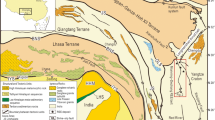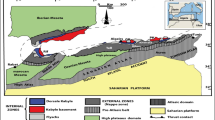Abstract
Textural relationships occurring in a range of settings from the Bayan Obo Fe-REE-Nb deposit, Inner Mongolia, China, indicate reaction between monazite [(REE)PO4], bastnäsite [(REE)(CO3)F] and apatite. Within dolomite marble-hosted ores monazite grains occur surrounded by zones of intergrown bastnäsite and apatite. In fluoritised dolomite marble-hosted amphibole-calcite veins, co-existing apatite and bastnäsite are separated by zones of monazite plus calcite, whilst in aegirine-apatite veins hosted by banded aegirine-fluorite-magnetite-bastnäsite rocks, they are separated by zones of monazite and fluorite. Modal proportions for minerals in the reaction zones have been used to derive reaction stoichiometries, and suggest the following reactions:
Consideration of these reactions, along with published experimental data and other reported mineral assemblages, suggests that the factors controlling the relative stabilities of monazite and bastnäsite are the pH, and the activities of HF °, CO3 2−, Ca2+ and PO4 3−. Textures indicating reaction between REE phosphates and fluorocarbonates have been reported from a number of other settings and are consistent with the controls on reaction inferred from this study. The range of assemblages seen at Bayan Obo is a result of the variation between relatively unbuffered fluid compositions, and those buffered by the fluoritisation of the carbonate host rock. Mass-balance calculations suggest some mobilisation of the REE into the fluid phase during reaction, although this did not significantly alter the REE distribution in monazite and bastnäsite. The mineral compositions also reveal variation in the REE distribution with different paragenetic settings indicating variation in the composition of the metasomatic fluids. These changes may be related to changes in the fluid source region, or to variations in the fluid chemistry, particularly X CO2, leading to different REE solubilities at different periods in the development of the deposit.
Similar content being viewed by others
Author information
Authors and Affiliations
Additional information
Received: 6 January 1998 / Accepted: 27 October 1998
Rights and permissions
About this article
Cite this article
Smith, M., Henderson, P. & Peishan, Z. Reaction relationships in the Bayan Obo Fe-REE-Nb deposit Inner Mongolia, China: implications for the relative stability of rare-earth element phosphates and fluorocarbonates. Contrib Mineral Petrol 134, 294–310 (1999). https://doi.org/10.1007/s004100050485
Published:
Issue Date:
DOI: https://doi.org/10.1007/s004100050485




